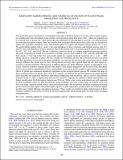Exoplanet Albedo Spectra and Colors as a Function of Planet Phase, Separation, and Metallicity
Author(s)
Cahoy, Kerri; Marley, Mark; Fortney, Jonathan
Download2010-10-30-Cahoy-et-al-AlbedoColors-of-Exoplanets.pdf (2.546Mb)
Metadata
Show full item recordAbstract
First generation space-based optical coronagraphic telescopes will obtain images of cool gas- and ice-giant exoplanets around nearby stars. Exoplanets lying at planet-star separations larger than about 1 AU—where an exoplanet can be resolved from its parent star—have spectra that are dominated by reflected light to beyond 1 μm and punctuated by molecular absorption features. Here, we consider how exoplanet albedo spectra and colors vary as a function of planet-star separation, metallicity, mass, and observed phase for Jupiter and Neptune analogs from 0.35 to 1 μm. We model Jupiter analogs with 1× and 3× the solar abundance of heavy elements, and Neptune analogs with 10× and 30× the solar abundance of heavy elements. Our model planets orbit a solar analog parent star at separations of 0.8 AU, 2 AU, 5 AU, and 10 AU. We use a radiative-convective model to compute temperature-pressure profiles. The giant exoplanets are found to be cloud-free at 0.8 AU, possess H2O clouds at 2 AU, and have both NH3 and H2O clouds at 5 AU and 10 AU. For each model planet we compute moderate resolution (R = λ/Δλ ~ 800) albedo spectra as a function of phase. We also consider low-resolution spectra and colors that are more consistent with the capabilities of early direct imaging capabilities. As expected, the presence and vertical structure of clouds strongly influence the albedo spectra since cloud particles not only affect optical depth but also have highly directional scattering properties. Observations at different phases also probe different volumes of atmosphere as the source-observer geometry changes. Because the images of the planets themselves will be unresolved, their phase will not necessarily be immediately obvious, and multiple observations will be needed to discriminate between the effects of planet-star separation, metallicity, and phase on the observed albedo spectra. We consider the range of these combined effects on spectra and colors. For example, we find that the spectral influence of clouds depends more on planet-star separation and hence atmospheric temperature than metallicity, and it is easier to discriminate between cloudy 1× and 3× Jupiters than between 10× and 30× Neptunes. In addition to alkalis and methane, our Jupiter models show H2O absorption features near 0.94 μm. While solar system giant planets are well separated by their broadband colors, we find that arbitrary giant exoplanets can have a large range of possible colors and that color alone cannot be relied upon to characterize planet types. We also predict that giant exoplanets receiving greater insolation than Jupiter will exhibit higher equator-to-pole temperature gradients than are found on Jupiter and thus may exhibit differing atmospheric dynamics. These results are useful for future interpretation of direct imaging exoplanet observations as well as for deriving requirements and designing filters for optical direct imaging instrumentation.
Date issued
2010-11-20Department
Space Telecommunications Astronomy and Radiation (STAR) Lab; Massachusetts Institute of Technology. Department of Aeronautics and AstronauticsPublisher
The Astrophysical Journal
Citation
Cahoy, K., M. Marley, J. Fortney, R. Freedman, and K. Lodders,“Exoplanet albedo spectra and colors as a function of planet phase, separation, and metallicity,” The Astrophysical Journal, Volume 724, Issue 1, pp. 189-214, 2010.
Keywords
planets and satellites, radiative transferring, scattering